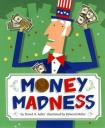David A. Adler’s brand new book, Money Madness, is not only highly-informative, but interactive and fun for young kids at the same time. The engaging illustrations by Edward Miller use both collages and images of real money.
The book begins with the question “What’s all this money madness?” and proceeds to tell its readers why people want and need money. Money Madness utilizes many scenarios in order to simplify topics for young readers. Within the first few pages, the author prompts children to “imagine a world without money…If there was no such thing as money and you needed new clothes, you would have to make them. Imagine if you had to knit your own sweater. Imagine if you had to raise a sheep to shear it, spin the wool to make the yarn, and then knit the sweater yourself.” Through Adler’s book, children not only learn the importance of money, but of it’s history as well.
Adler introduces his readers to the idea of bartering before there was such a thing as money. He shows children through many examples how it would be difficult to barter, because the trades wouldn’t always be fair, and sometimes what you wanted that person did not have. Adler also shows children the many different forms of money before it became what it is today: “At one time cows, sheep, camels, rocks, feathers, salt, dried fish, fishhooks, animals skins, and strings made of beads made from clamshells were all used as money.” Then Adler uses real images of metal money to introduce to students the concept of money as a metal, and how it eventually developed into the coins we have today, and finally into bills as well. On one fun page, the author shows the bills and their names from all over the world. At the end of Money Madness, Adler does a brief introduction to inflation and using credit cards and checks as a substitute for money. Young readers will learn through this book not only the history and use of money, but of it’s importance in our world.
Curriculum Connections
This highly informational yet simple book can be used when introducing students to money and its importance. But it can also be used for more complex topics, such as different currency, bartering, and inflation. Money Madness would correlate well with the SOLs 2.8, which introduces the idea of bartering, or 2.9, which shows how limited resources require people to make choices about what to produce and/or consume. Money Madness could also be used for Virginia Studies, for example for SOL VS.4d, where students have to describe how Virginia colonies used money, barter and credit.
Additional Resources
- Allow your students to follow Wise Pocket’s friends in their stories about earning, spending, and saving money.
- This website shares many great activities for teaching your students about bartering.
- The US Mint’s kid-friendly site has many great economics activities, including this one where students can examine currency from all over the world.
General Information
Book: Money Madness
Author: David A. Adler
Illustrator: Edward Miller
Publisher: Holiday House
Publication Date: 2009
Pages: 24
Grade Range: 2-5
ISBN: 0823414744

